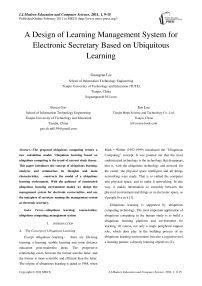A Design of Learning Management System for Electronic Secretary Based on Ubiquitous Learning
Автор: Guangran Liu, Bencai Gao, Jun Lou
Журнал: International Journal of Modern Education and Computer Science (IJMECS) @ijmecs
Статья в выпуске: 1 vol.3, 2011 года.
Бесплатный доступ
The proposed ubiquitous computing creates a new calculation model. Ubiquitous learning based on ubiquitous computing is the trend of current study theory. This paper introduces the concept of ubiquitous learning, analyzes and summarizes its thoughts and main characteristics, constructs the model of a ubiquitous learning environment. With the guidance of constructed ubiquitous learning environment model, we design the management system for electronic course-lattice, and use the metaphor of secretary naming the management system as electronic secretary.
Короткий адрес: https://sciup.org/15010043
IDR: 15010043
Список литературы A Design of Learning Management System for Electronic Secretary Based on Ubiquitous Learning
- Mark Weiser. Hot Topic: Ubiquitous Computing [J].IEEE Computer, 1993,(10):71-72.
- Hwang, G. J., Yang, T. C., Tsai, C.C. & Yang, S. J. H. (2009). A context-aware ubiquitous learning environment for conducting complex science experiments. Computers & Education, 53(2), 402-413.
- Chen, Y.S., Kao, T.C., Sheu, J.P. and Chiang, C.Y.(2002).A Mobile Scaffolding-A id-Based Bird-Watching Learning System. In M. Milrad, H. U. Hoppe and Kinshuk(Eds.), IEEE International Workshop on W ireless and Mobile Technologies in Education(pp.15-22).Los Alamitos, USA:IEEE Computer Society.
- Soo-Hwan Kim, HyeonCheol Kim. Jin-Tae Lee, Seon-Kwan Han. Chul-Hyun Lee(2008). A design of u-Learning system based on memory theories in ubiquitous environments. Wseas Transactions on Advance in Engineering Education 2008, Volume 5(pp.77-82).
- Reeves, T.C., Herrington, J., & O liver, R. (2002).Authentic activities and online learning. In A. Goody, J. Herrington, & M. North cote (Eds.), Quality conversations: Research and Development in Higher Education, Volume 25 (pp.562-567).
- Liu, G. Z. & Hwang, G. J. (2009). A key step to understanding paradigm shifts in e-learning: Towards context-aware ubiquitous learning. British Journal of Educational Technology, 40(6), doi: 10.1111/j.1467-8535.2009.00976.x
- Jones, V. & Jo, J.H. (2004). Ubiquitous learning environment: An adaptive teaching system using ubiquitous technology. In R. Atkinson, C. McBeath, D. Jonas-Dwyer & R. Phillips (Eds), Beyond the comfort zone: Proceedings of the 21st ASCILITE Conference (pp. 468-474).
- CBAIR.air:http://www.hepu.com.cn/
- http:∥www. drupalsites. net/ [ EB] . 2006-07-23.
- http:∥top. drupalsites. net/ [ EB] . 2006-07-23.
- A.K.Dey,A.Understanding and Using Context[J]. Journal of Personal and Ubiquitous Computing,2001,5(1):4-7.
- Friedemann Mattern.Ubiquitous Computing:From smart Devices to smart every Dey objects[J]. Information Appliances, 2000,(3):6-12.
- Koper, E. J. R. , & Sloep, P. ( 2003) . Learning networks: connecting peop le, organizations, autonomous agents and learning resources to establish the emergence of effective lifelong learning (OTECRTD Programme Plan 2003-2008 ) [M]. Heerlen: Open University ofthe Netherlands.
- Wagner, A. (2000) . Tertiary education and lifelong learning: perspectives, findings and issues from OECD work [J]. Higher Education Management, 11 (1) : 55256.
- Daniel, J. S. (1996 ) . Mega2universities and knowledgemedia: Technology strategies for higher education [M]. London: Kogan Page.
- Johan Plomp, Petteri Alahuhta. A Platform for Ubiquitous ContextSensitive Applications [DB/OL].www.inf.ethj.ch/vs/ events/HUK2kW/AlahuhtaPlomp.pdf.


